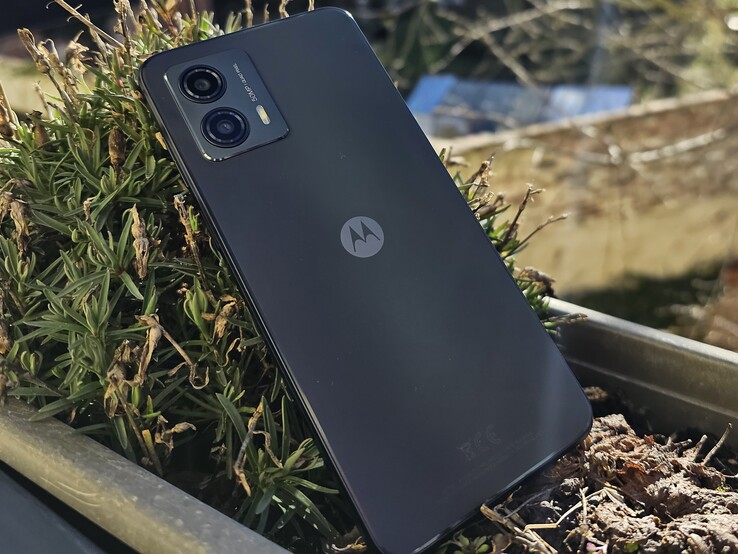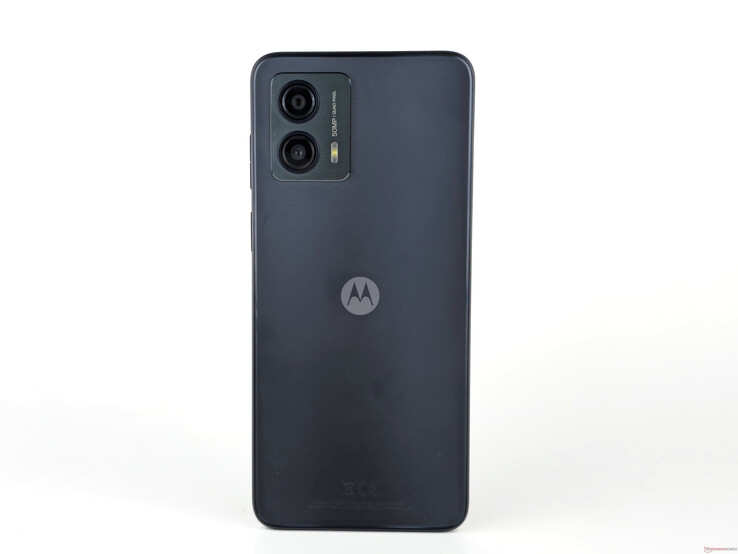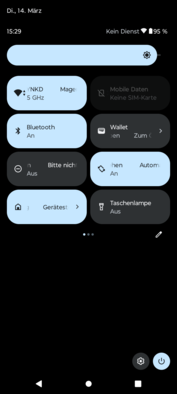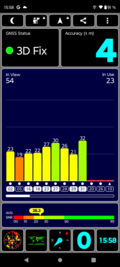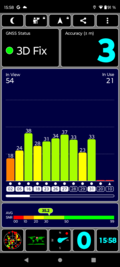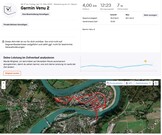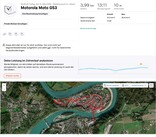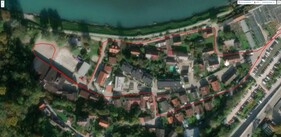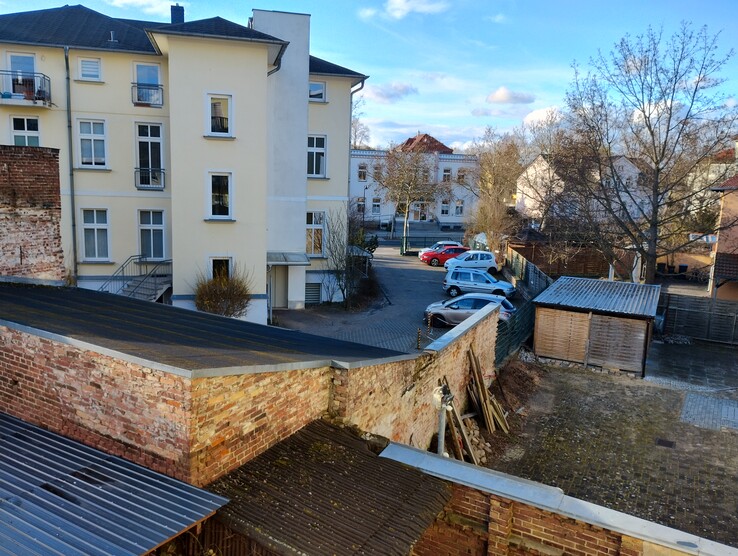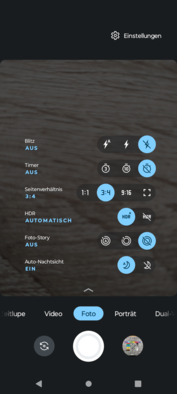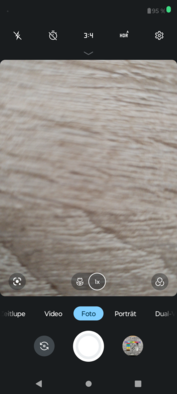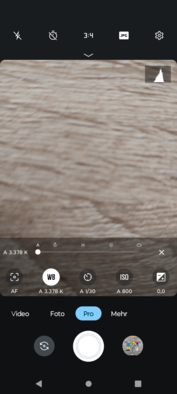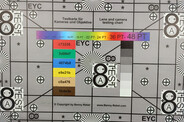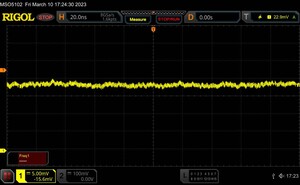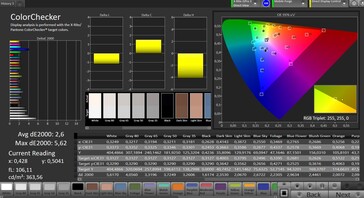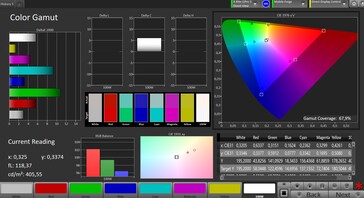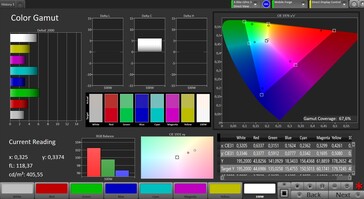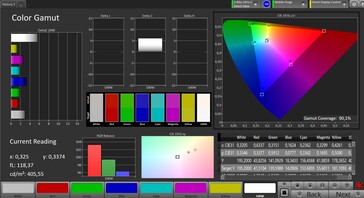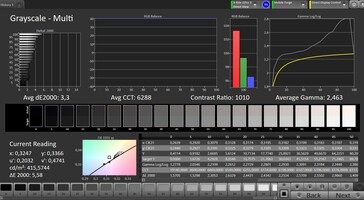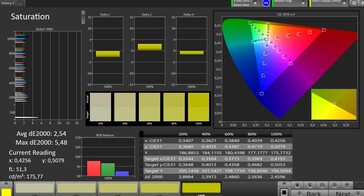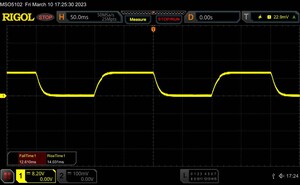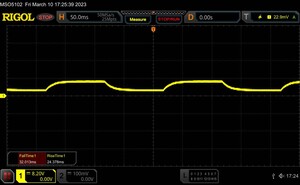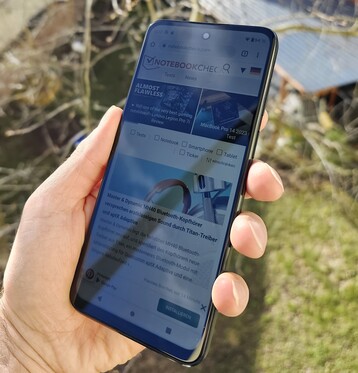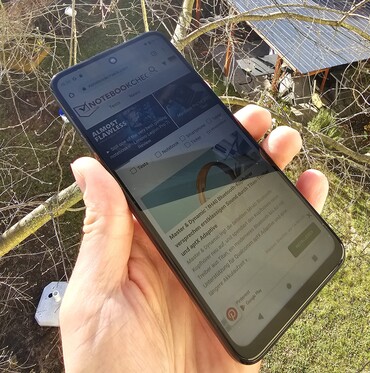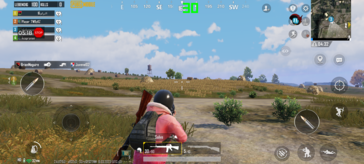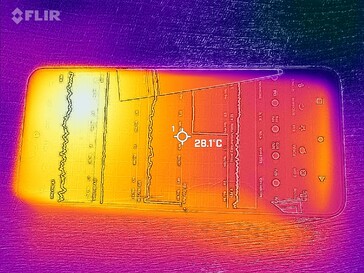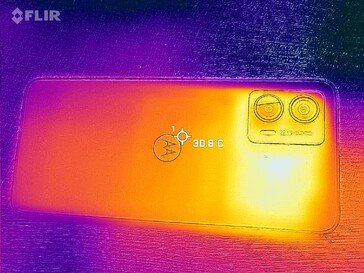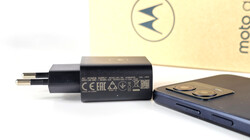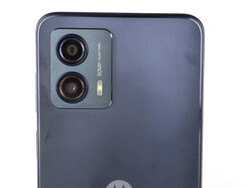Motorola Moto G53 5G review: Affordable 5G smartphone with 120 Hz and 50 MP camera
The Moto G53 focuses on lean software such as security features and on multimedia use with its Dolby Atmos-certified stereo speakers and 6.5-inch 120 Hz screen. However, the IPS panel only has a meager resolution of 1600x720 (HD+) and a pixel density of 269 ppi.
Motorola has installed Qualcomm's Snapdragon 480+ chipset, which, in contrast to its predecessor, now enables access to the 5G network. In addition, Motorola combines 4 GB of RAM with 128 GB of internal storage for an RRP of US$200-325(depending on location).
A supposed highlight is the rear main camera with the ISOCELL JN1, which is also used in the Samsung Galaxy A23 5G. With a sensor size of 1/2.76 inch and a resolution of 50 MP, the pixels are, however, quite small at 0.64 µm. At least 1.28 micrometer virtual pixels are achieved with SOCELL 2.0 technology.
Possible Competitors in Comparison
Rating | Date | Model | Weight | Drive | Size | Resolution | Price |
|---|---|---|---|---|---|---|---|
| 79.1 % v7 (old) | 03 / 2023 | Motorola Moto G53 SD 480+, Adreno 619 | 183 g | 128 GB UFS 2.1 Flash | 6.50" | 1600x720 | |
| 79.2 % v7 (old) | 01 / 2023 | Realme 10 Helio G99, Mali-G57 MP2 | 178 g | 128 GB UFS 2.2 Flash | 6.40" | 2400x1080 | |
| 82.5 % v7 (old) | 07 / 2022 | Xiaomi Poco X4 Pro SD 695 5G, Adreno 619 | 205 g | 128 GB UFS 2.2 Flash | 6.67" | 2400x1080 | |
| 80.3 % v7 (old) | 10 / 2022 | Samsung Galaxy A23 5G SD 695 5G, Adreno 619 | 197 g | 64 GB UFS 2.2 Flash | 6.60" | 2408x1080 | |
| 80.2 % v7 (old) | 10 / 2022 | Oppo A77 5G Dimensity 810, Mali-G57 MP2 | 190 g | 64 GB UFS 2.2 Flash | 6.56" | 1612x720 | |
| 81 % v7 (old) | 07 / 2022 | Motorola Moto G52 SD 680, Adreno 610 | 169 g | 128 GB UFS 2.1 Flash | 6.60" | 2400x1080 |
Case - Moto G53 with punch hole
The inexpensive Motorola smartphone is equipped with a punch hole in which the 16 MP selfie camera is housed. Made of plastic, the Moto G53's case is solidly built and can be purchased in three colors, namely Ink Blue, Arctic Silver, and Pale Pink.
The surface of the back is matte, which resists greasy smudges well enough. Unlike the Moto G52, the successor lacks IP52 certification. Instead, the Moto G53 only uses a water-resistant design. The manufacturer specifies this as protection against splashes of water or light rain.
The bezel just below the IPS panel is quite wide. Expressed in numbers: less than 84 percent of the smartphone's front side is attributable to the display. As a result, the 6.5-inch Moto G53 is not exactly compact. A dedicated Google Assistant button, as in other Moto models, is not installed in the Moto G53.
Equipment - Motorola smartphone with 3.5 mm jack
In addition to stereo speakers and the dual-SIM function, features of the mid-range smartphone include an NFC chip and USB OTG for quickly connecting external accessories. The wireless image transmission of screen content (Miracast) also worked without issue under testing. A USB Type-C port that supports the USB 2.0 standard is available for wired data transfer
Buyers of the Moto phone also have access to an audio jack for headphones, and thanks to DRM Widevine L1, streaming content can be viewed in HD quality.
microSD Card Reader
The integrated microSD slot supports the current SDHC and SDXC standards up to 1 TB. The Moto G53's copying speed of 27 MB/s is solid, but a Samsung Galaxy A23 copies pictures much faster. Nevertheless, in tandem with our AV PRO V60 reference card, the microSD slot performs well with good values in the Cross Platform Disk Test.
| SD Card Reader - average JPG Copy Test (av. of 3 runs) | |
| Samsung Galaxy A23 5G (Angelbird V60) | |
| Realme 10 (Angelbird V60) | |
| Motorola Moto G53 (Angelbird V60) | |
| Oppo A77 5G (Angelbird V60) | |
| Motorola Moto G52 (Angelbird V60) | |
| Xiaomi Poco X4 Pro (Angelbird AV Pro V60) | |
Cross Platform Disk Test (CPDT)
Software - Motorola smartphone with Android 13
Motorola uses its own MyUX interface for its mid-range smartphone, which complements Google's Android (version 13). During our review period, the security patches on our Moto G53 were from January 2023. According to the manufacturer, security patches will be discontinued from January 2026 and will be released in intervals of two months. This is very commendable for a middle-range smartphone. However, there is a downside to the Android upgrades - the Moto G53 will only receive the next generation, namely Android 14.
The Moto G53's MyUX UI does not offer the company's Ready For functionality, but the supports a bundle of hardware and software security functions called ThinkShield for Mobile. There is also the new Moto Secure app, which allows users to adjust privacy controls and security features or hide apps and files in a secure folder protected by a PIN. Sensitive apps, such as those from the financial sector, can also be hidden through neutral app icons and naming options.
Communication and GNSS - Moto G53 with 5G
In terms of communication, the Moto smartphone only uses Bluetooth 5.1, although the Snapdragon 480 Plus theoretically supports Bluetooth 5.2 - this is probably due to an error in Motorola's data sheet, since the LC3 codec is listed in the developer options for the Moto G53. In addition to 5G support, the mid-range smartphone connects to the mobile internet via 16 LTE bands. For home WLAN, the Moto G53 offers rather standard fare with WiFi 5, which still delivers competitive transfer rates in our measurements. In tandem with our Asus ROG Rapture GT-AXE11000 reference router, the Moto smartphone behaved consistently both when receiving and sending data.
In order to better assess positioning accuracy in everyday use, we took the Moto G53 on a short bike ride and recorded the route in parallel with a Garmin Venue 2 for comparison purposes. Although the localization capabilities of the Motorola smartphone are not always perfect, deviations in the detailed summary of the GPS recording are minor. No notable inaccuracies arise in the course of the almost 4 km long journey with the Moto G53
The positioning module of the Moto smartphone uses the main satellite systems GPS (L1+L5), GLONASS (L1), BeiDou (B1) and Galileo (E1) to determine its location. The satellite-based supplemental system SBAS is also used.
Telephony and Voice Quality - Motorola smartphone with dual SIM
In our tests, we liked the voice quality produced by the Moto smartphone, but its SAR values are relatively high at almost one watt per kilogram (head) and 1.3 W/kg (body). Standards such as VoLTE or WLAN calls are supported. During our test calls with the Moto G53, voices were reproduced clearly and also characterized as clear by our conversation partner. Thanks to the two well-functioning microphones, the Moto smartphone also cuts a fine figure in video conferencing (tested via Skype) and via the stereo speakers.
Cameras - Motorola smartphone with dual cam
The camera setup of the Moto G53 is certainly not the greatest in terms of flexibility and versatility. On the front, there is a 16 MP camera that can record videos in a maximum resolution of 1080p. Photos are appealingly sharp in difficult lighting conditions and well exposed in portrait mode.
Motorola clearly focuses on the wide-angle camera in the Moto G53 - because the second lens is only used for macro photography and has a very low resolution of 2 MP. The main camera is Samsung's ISOCELL JN1 sensor, which is also used in the Galaxy A23 5G. The 50 MP sensor has an f/1.8 aperture and captures subjects with a high level of contrast. In addition to the pixel binning process, in which 4 pixels are merged to form a huge "super pixel", a 50 MP mode can also be used. In daylight and, surprisingly, also in the dark, the Moto G53 takes attractively sharp photos. Due to the rather small image sensor, the photos are not perfectly illuminated in low light, but they are more than convincing for the price range.
Under controlled lighting conditions, we used the ColorChecker Passport to analyze the color representation of the 50 MP optics in comparison to the actual reference colors. Those who value an exact color representation are unlikely to be happy with the Moto G53. Aside from the smartphone-typical brightness, the Moto Phone reveals relatively large deviations in the ColorChecker, especially in the green and blue tones.
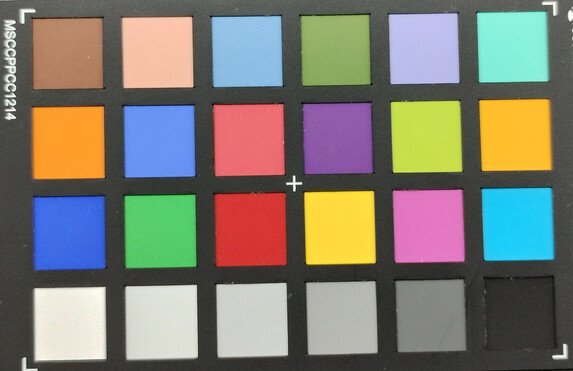

Accessories and Warranty - Moto G53 with power adapter
The scope of delivery includes a modular 10-watt power supply, a data and charging cable, a SIM pin, and a quick start guide with warranty information. In addition to a protective case that Motorola does not include with its Moto G53, the predecessor also came with the 33-watt TurboPower charger. The step backwards here is incomprehensible, especially since the battery capacity has remained unchanged at 5,000 mAh. The manufacturer provides a 24-month warranty for the Moto G53 in Germany. This may differ in other countries, so buyers should double check before purchase.
Optional and extended insurance coverage is also available via Motorola's online shop for around US$20, under which the Moto G53 is insured against defects and mechanical failure for an additional 12 months. An optional accident protection contract called Moto Care offers additional coverage for liquid or property damage. For this, Motorola charges around US$40 extra for 24 months.
Input Devices & Operation - Motorola smartphone with FaceUnlock
The capacitive touchscreen of the Moto G53 reliably recognizes our finger inputs. In addition to the high refresh rate of 120 Hz, the low touch latency also benefits smartphone operation. The Moto G53 scans for possible user touches in certain applications (such as games) up to 250 times per second. Via the front camera, the Moto smartphone can be unlocked via facial recognition, but this is done using a 2D process and is thus not very secure. A fingerprint scanner has been integrated into the power button for a secure biometric unlocking option, which performs well with a good recognition rate. The positioning is also comfortable for our taste. However, the unlocking process until the display turns on takes a certain amount of time.
Display - Moto G53 with IPS panel instead of OLED
Display fetishists will certainly not be happy with the Moto G53, as Motorola has cut back here compared to the predecessor. The high-contrast OLED panel of the Moto G52 with a 1080p resolution has been replaced by an IPS panel with a low pixel density of 269 ppi in the 2023 model. At least the refresh rate has been increased to 120 Hz. Those wanting to save some energy can set the screen at 60 Hz. The smartphone also offers an automatic mode.
In our brightness measurements, the IPS panel achieves an average of 559 cd/m² on a full white display, which is satisfactory for this price range, but less than the Moto G52. The APL18 measurement, which is more representative of everyday use, registered 602 cd/m² in the center of the image. Another solid value, but the predecessor is also brighter here at around 664 cd/m² (APL50).
No screen flickering (PWM) was detected in the Moto G53 due to LC display technology. The IPS-typical weaknesses (shading, uneven lighting at the edges) are also not very pronounced in Motorola's smartphone.
| |||||||||||||||||||||||||
Brightness Distribution: 91 %
Center on Battery: 587 cd/m²
Contrast: 1468:1 (Black: 0.4 cd/m²)
ΔE ColorChecker Calman: 2.6 | ∀{0.5-29.43 Ø4.78}
ΔE Greyscale Calman: 3.3 | ∀{0.09-98 Ø5}
90.1% sRGB (Calman 2D)
Gamma: 2.463
CCT: 6288 K
| Motorola Moto G53 IPS, 1600x720, 6.5" | Realme 10 AMOLED, 2400x1080, 6.4" | Xiaomi Poco X4 Pro AMOLED, 2400x1080, 6.7" | Samsung Galaxy A23 5G PLS, 2408x1080, 6.6" | Oppo A77 5G IPS, 1612x720, 6.6" | Motorola Moto G52 AMOLED, 2400x1080, 6.6" | |
|---|---|---|---|---|---|---|
| Screen | -29% | 33% | -43% | -16% | 32% | |
| Brightness middle (cd/m²) | 587 | 553 -6% | 687 17% | 447 -24% | 592 1% | 655 12% |
| Brightness (cd/m²) | 559 | 553 -1% | 694 24% | 428 -23% | 566 1% | 649 16% |
| Brightness Distribution (%) | 91 | 91 0% | 96 5% | 86 -5% | 90 -1% | 95 4% |
| Black Level * (cd/m²) | 0.4 | 0.31 22% | 0.4 -0% | |||
| Contrast (:1) | 1468 | 1442 -2% | 1480 1% | |||
| Colorchecker dE 2000 * | 2.6 | 4.23 -63% | 1.2 54% | 5.54 -113% | 4.62 -78% | 1.1 58% |
| Colorchecker dE 2000 max. * | 5.62 | 10.83 -93% | 4 29% | 10.04 -79% | 6.5 -16% | 2.58 54% |
| Greyscale dE 2000 * | 3.3 | 3.6 -9% | 1 70% | 7.3 -121% | 4.5 -36% | 1.7 48% |
| Gamma | 2.463 89% | 2.24 98% | 2.16 102% | 2.03 108% | 2.32 95% | 2.212 99% |
| CCT | 6288 103% | 7171 91% | 6496 100% | 8853 73% | 7653 85% | 6557 99% |
* ... smaller is better
Screen Flickering / PWM (Pulse-Width Modulation)
| Screen flickering / PWM not detected | |||
In comparison: 53 % of all tested devices do not use PWM to dim the display. If PWM was detected, an average of 8108 (minimum: 5 - maximum: 343500) Hz was measured. | |||
Messreihe mit fixer Zoomstufe und unterschiedlichen Helligkeitseinstellungen
The IPS panel's black level of 0.4 cd/m² gives the Moto G53 a good contrast ratio of around 1,500:1, but the black level is not really convincing when compared to the OLED competition, because black areas on the screen have a slight grey haze. The mid-range smartphone only has two color profiles for which the color temperature can be adjusted. The calibration of the AMOLED panel was examined using the Calman analysis software. Our measured DeltaE values for the sRGB color space indicate a small deviation in the colors (<3). Differences are particularly noticeable in magenta and blue. The representation of the grayscales also shows a slight deviation, but here we are just outside the target range of less than 3.
Display Response Times
| ↔ Response Time Black to White | ||
|---|---|---|
| 26.6 ms ... rise ↗ and fall ↘ combined | ↗ 12.6 ms rise | |
| ↘ 14 ms fall | ||
| The screen shows relatively slow response rates in our tests and may be too slow for gamers. In comparison, all tested devices range from 0.1 (minimum) to 240 (maximum) ms. » 66 % of all devices are better. This means that the measured response time is worse than the average of all tested devices (20.2 ms). | ||
| ↔ Response Time 50% Grey to 80% Grey | ||
| 56 ms ... rise ↗ and fall ↘ combined | ↗ 32 ms rise | |
| ↘ 24 ms fall | ||
| The screen shows slow response rates in our tests and will be unsatisfactory for gamers. In comparison, all tested devices range from 0.165 (minimum) to 636 (maximum) ms. » 92 % of all devices are better. This means that the measured response time is worse than the average of all tested devices (31.6 ms). | ||
The Moto G53 is well equipped for everyday outdoor use. Content remains legible in direct sunlight due to the moderate brightness, but reflections on the glass surface should be avoided.
The viewing angle stability of the IPS panel is okay, but a strong loss of brightness is noticeable at very flat viewing angles. Changes in the colors are hardly noticeable.
Performance - Motorola smartphone with Qualcomm SoC
The Moto smartphone is powered by a Snapdragon 480 Plus, which integrates a total of eight cores divided into two clusters. Thanks to the two Cortex A76 cores, the Moto G53 achieves solid performance values for its price range, although the Snapdragon 695 in the Poco X4 Pro or Galaxy A23 performs around 20 percent better in Geekbench. In the PCMark system benchmark, on the other hand, the Moto G53's scores are much more appealing.
| UL Procyon AI Inference for Android - Overall Score NNAPI | |
| Average of class Smartphone (3769 - 81594, n=135, last 2 years) | |
| Xiaomi Poco X4 Pro | |
| Average Qualcomm Snapdragon 480 Plus 5G (5126 - 6690, n=3) | |
| Motorola Moto G53 | |
| AImark - Score v3.x | |
| Average of class Smartphone (82 - 307528, n=122, last 2 years) | |
| Motorola Moto G53 | |
| Average Qualcomm Snapdragon 480 Plus 5G (413 - 424, n=2) | |
The Adreno 619 installed in the Qualcomm-SoC handles graphical tasks significantly better than the Adreno 610 in the predecessor, but the results of the Moto G53 are lower than those of the mid-range competition. In 3DMark in particular, the Moto smartphone is almost 30 percent behind the Mali-G57 MP2 in the realme 10. Owing to the low HD+ resolution, the Moto G53 performs better than the 1080p comparison devices in the GFXBench on-screen values, as expected.
GFXBench (DX / GLBenchmark) 2.7: T-Rex Onscreen | 1920x1080 T-Rex Offscreen
GFXBench 3.0: on screen Manhattan Onscreen OGL | 1920x1080 1080p Manhattan Offscreen
GFXBench 3.1: on screen Manhattan ES 3.1 Onscreen | 1920x1080 Manhattan ES 3.1 Offscreen
GFXBench: on screen Car Chase Onscreen | 1920x1080 Car Chase Offscreen | on screen Aztec Ruins High Tier Onscreen | 2560x1440 Aztec Ruins High Tier Offscreen | on screen Aztec Ruins Normal Tier Onscreen | 1920x1080 Aztec Ruins Normal Tier Offscreen
| 3DMark / Wild Life Extreme Unlimited | |
| Xiaomi Poco X4 Pro | |
| Realme 10 | |
| Samsung Galaxy A23 5G | |
| Oppo A77 5G | |
| Motorola Moto G53 | |
| Motorola Moto G52 | |
| 3DMark / Wild Life Extreme | |
| Realme 10 | |
| Xiaomi Poco X4 Pro | |
| Oppo A77 5G | |
| Samsung Galaxy A23 5G | |
| Motorola Moto G53 | |
| Motorola Moto G52 | |
| 3DMark / Wild Life Unlimited Score | |
| Realme 10 | |
| Oppo A77 5G | |
| Xiaomi Poco X4 Pro | |
| Samsung Galaxy A23 5G | |
| Motorola Moto G53 | |
| Motorola Moto G52 | |
| 3DMark / Wild Life Score | |
| Realme 10 | |
| Oppo A77 5G | |
| Xiaomi Poco X4 Pro | |
| Samsung Galaxy A23 5G | |
| Motorola Moto G53 | |
| Motorola Moto G52 | |
| 3DMark / Sling Shot Extreme (Vulkan) Unlimited Physics | |
| Motorola Moto G53 | |
| Samsung Galaxy A23 5G | |
| Realme 10 | |
| Oppo A77 5G | |
| Xiaomi Poco X4 Pro | |
| Motorola Moto G52 | |
| 3DMark / Sling Shot Extreme (Vulkan) Unlimited Graphics | |
| Xiaomi Poco X4 Pro | |
| Samsung Galaxy A23 5G | |
| Oppo A77 5G | |
| Realme 10 | |
| Motorola Moto G53 | |
| Motorola Moto G52 | |
| 3DMark / Sling Shot Extreme (Vulkan) Unlimited | |
| Xiaomi Poco X4 Pro | |
| Samsung Galaxy A23 5G | |
| Oppo A77 5G | |
| Realme 10 | |
| Motorola Moto G53 | |
| Motorola Moto G52 | |
| 3DMark / Sling Shot Extreme (ES 3.1) Unlimited Physics | |
| Realme 10 | |
| Oppo A77 5G | |
| Xiaomi Poco X4 Pro | |
| Motorola Moto G53 | |
| Samsung Galaxy A23 5G | |
| Motorola Moto G52 | |
| 3DMark / Sling Shot Extreme (ES 3.1) Unlimited Graphics | |
| Xiaomi Poco X4 Pro | |
| Samsung Galaxy A23 5G | |
| Realme 10 | |
| Oppo A77 5G | |
| Motorola Moto G53 | |
| Motorola Moto G52 | |
| 3DMark / Sling Shot Extreme (ES 3.1) Unlimited | |
| Xiaomi Poco X4 Pro | |
| Samsung Galaxy A23 5G | |
| Realme 10 | |
| Oppo A77 5G | |
| Motorola Moto G53 | |
| Motorola Moto G52 | |
| 3DMark / Sling Shot Extreme (ES 3.1) | |
| Xiaomi Poco X4 Pro | |
| Samsung Galaxy A23 5G | |
| Realme 10 | |
| Oppo A77 5G | |
| Motorola Moto G53 | |
| Motorola Moto G52 | |
| 3DMark / Sling Shot Extreme (ES 3.1) Graphics | |
| Xiaomi Poco X4 Pro | |
| Samsung Galaxy A23 5G | |
| Realme 10 | |
| Oppo A77 5G | |
| Motorola Moto G53 | |
| Motorola Moto G52 | |
| 3DMark / Sling Shot Extreme (ES 3.1) Physics | |
| Xiaomi Poco X4 Pro | |
| Samsung Galaxy A23 5G | |
| Realme 10 | |
| Oppo A77 5G | |
| Motorola Moto G52 | |
| Motorola Moto G53 | |
| GFXBench (DX / GLBenchmark) 2.7 / T-Rex Onscreen | |
| Motorola Moto G53 | |
| Xiaomi Poco X4 Pro | |
| Samsung Galaxy A23 5G | |
| Motorola Moto G52 | |
| GFXBench (DX / GLBenchmark) 2.7 / T-Rex Offscreen | |
| Xiaomi Poco X4 Pro | |
| Samsung Galaxy A23 5G | |
| Motorola Moto G53 | |
| Motorola Moto G52 | |
| GFXBench 3.0 / Manhattan Onscreen OGL | |
| Motorola Moto G53 | |
| Xiaomi Poco X4 Pro | |
| Samsung Galaxy A23 5G | |
| Motorola Moto G52 | |
| GFXBench 3.0 / 1080p Manhattan Offscreen | |
| Xiaomi Poco X4 Pro | |
| Samsung Galaxy A23 5G | |
| Motorola Moto G53 | |
| Motorola Moto G52 | |
| GFXBench 3.1 / Manhattan ES 3.1 Onscreen | |
| Motorola Moto G53 | |
| Xiaomi Poco X4 Pro | |
| Samsung Galaxy A23 5G | |
| Motorola Moto G52 | |
| GFXBench 3.1 / Manhattan ES 3.1 Offscreen | |
| Xiaomi Poco X4 Pro | |
| Samsung Galaxy A23 5G | |
| Motorola Moto G53 | |
| Motorola Moto G52 | |
| GFXBench / Car Chase Onscreen | |
| Motorola Moto G53 | |
| Xiaomi Poco X4 Pro | |
| Samsung Galaxy A23 5G | |
| Motorola Moto G52 | |
| GFXBench / Car Chase Offscreen | |
| Xiaomi Poco X4 Pro | |
| Samsung Galaxy A23 5G | |
| Motorola Moto G53 | |
| Motorola Moto G52 | |
| GFXBench / Aztec Ruins High Tier Onscreen | |
| Motorola Moto G53 | |
| Oppo A77 5G | |
| Xiaomi Poco X4 Pro | |
| Samsung Galaxy A23 5G | |
| Realme 10 | |
| Motorola Moto G52 | |
| GFXBench / Aztec Ruins High Tier Offscreen | |
| Motorola Moto G53 | |
| Xiaomi Poco X4 Pro | |
| Samsung Galaxy A23 5G | |
| Realme 10 | |
| Oppo A77 5G | |
| Motorola Moto G52 | |
| GFXBench / Aztec Ruins Normal Tier Onscreen | |
| Oppo A77 5G | |
| Motorola Moto G53 | |
| Xiaomi Poco X4 Pro | |
| Samsung Galaxy A23 5G | |
| Realme 10 | |
| Motorola Moto G52 | |
| GFXBench / Aztec Ruins Normal Tier Offscreen | |
| Xiaomi Poco X4 Pro | |
| Samsung Galaxy A23 5G | |
| Realme 10 | |
| Motorola Moto G53 | |
| Oppo A77 5G | |
| Motorola Moto G52 | |
| Jetstream 2 - 2.0 Total Score | |
| Average of class Smartphone (23.8 - 387, n=149, last 2 years) | |
| Motorola Moto G53 (Chrome 111) | |
| Samsung Galaxy A23 5G (Chrome 106) | |
| Average Qualcomm Snapdragon 480 Plus 5G (61.8 - 69.5, n=3) | |
| Xiaomi Poco X4 Pro (Chrome 103) | |
| Motorola Moto G52 (Chrome 103) | |
| Speedometer 2.0 - Result 2.0 | |
| Average of class Smartphone (15.2 - 643, n=122, last 2 years) | |
| Motorola Moto G53 (Chrome 111) | |
| Average Qualcomm Snapdragon 480 Plus 5G (42.3 - 47.8, n=3) | |
| Xiaomi Poco X4 Pro (Chrome 103) | |
| Samsung Galaxy A23 5G (Chome 106) | |
| Motorola Moto G52 (Chrome 103) | |
| WebXPRT 4 - Overall | |
| Average of class Smartphone (27 - 306, n=145, last 2 years) | |
| Motorola Moto G53 (Chrome 111) | |
| Average Qualcomm Snapdragon 480 Plus 5G (63 - 77, n=2) | |
| Xiaomi Poco X4 Pro (Chrome 103) | |
| Samsung Galaxy A23 5G (Chrome 106) | |
| Octane V2 - Total Score | |
| Average of class Smartphone (2228 - 121337, n=197, last 2 years) | |
| Xiaomi Poco X4 Pro (Chrome 103) | |
| Realme 10 (Chrome 109) | |
| Motorola Moto G53 (Chrome 111) | |
| Samsung Galaxy A23 5G (Chrome 106) | |
| Average Qualcomm Snapdragon 480 Plus 5G (19795 - 20938, n=3) | |
| Oppo A77 5G (Chrome 106) | |
| Motorola Moto G52 (Chrome 103) | |
| Mozilla Kraken 1.1 - Total | |
| Motorola Moto G52 (Chrome 103) | |
| Average Qualcomm Snapdragon 480 Plus 5G (1829 - 2280, n=3) | |
| Xiaomi Poco X4 Pro (Chrome 103) | |
| Samsung Galaxy A23 5G (Chrome 106) | |
| Motorola Moto G53 (Chrome 111) | |
| Average of class Smartphone (257 - 28190, n=154, last 2 years) | |
* ... smaller is better
Motorola does not provide any information regarding the UFS storage connection. Based on the determined values, the manufacturer has likely installed the 2.1 standard again, as in the predecessor. However, the AndroBench benchmark does not attest to the Moto G53's high performance. The read rates of less than 500 MBit/s in particular are extremely low. The Qualcomm SoC seems to limit speeds here, since the Moto G51 also has a similar data throughput.
| Motorola Moto G53 | Realme 10 | Xiaomi Poco X4 Pro | Samsung Galaxy A23 5G | Oppo A77 5G | Motorola Moto G52 | Average 128 GB UFS 2.1 Flash | Average of class Smartphone | |
|---|---|---|---|---|---|---|---|---|
| AndroBench 3-5 | 77% | 26% | 33% | 63% | 46% | 17% | 312% | |
| Sequential Read 256KB (MB/s) | 474.6 | 881 86% | 303.4 -36% | 485.1 2% | 908.5 91% | 893.44 88% | 761 ? 60% | 2228 ? 369% |
| Sequential Write 256KB (MB/s) | 243.87 | 530.1 117% | 483.33 98% | 487.4 100% | 492.8 102% | 503.56 106% | 296 ? 21% | 1851 ? 659% |
| Random Read 4KB (MB/s) | 166.24 | 200.5 21% | 193.45 16% | 188.2 13% | 182.4 10% | 98.99 -40% | 154 ? -7% | 296 ? 78% |
| Random Write 4KB (MB/s) | 139.83 | 257.7 84% | 173.03 24% | 163.1 17% | 206.3 48% | 182.92 31% | 130.4 ? -7% | 337 ? 141% |
Gaming - Moto G53 manages 120 fps
In order to assess the GPU power of the Moto G53 not only in the graphics benchmarks, but also in gaming, we took a closer look at two Android titles from the Play Store using software from our partner GameBench.
Both Android games run mostly smoothly and with only a few frame drops. However, the Moto smartphone does not manage to exceed the 40 fps limit in PUBG Mobile, no matter which graphics setting we choose. In HD mode, the Moto G53 runs at just 30 fps.
Surprisingly, the native 120 fps of the IPS panel is possible in Armajet. On average, the Moto G53 "only" achieves 98 fps, but even current high-end smartphones such as the Vivo X90 Pro are unable to average more than 60 fps in the 2D multiplayer shooter due to frame locks. So the low-priced Motorola mid-range can score some points here.
Emissions - Motorola phone stays quite cool
Temperature
The Moto G53 gets noticeably warm in our load scenario with a peak of just under 42 °C, but not uncomfortably hot. It is interesting to see whether the low heat development of the mid-range smartphone negatively impacts the performance of the Qualcomm SoC.
In the 3DMark stress tests, we monitored the behavior of the Snapdragon 480 Plus under sustained load. We get values of over 95 percent for the Moto G53, which attests to the system's consistent performance.
(±) The maximum temperature on the upper side is 40.8 °C / 105 F, compared to the average of 35.2 °C / 95 F, ranging from 21.9 to 247 °C for the class Smartphone.
(±) The bottom heats up to a maximum of 41.6 °C / 107 F, compared to the average of 34 °C / 93 F
(+) In idle usage, the average temperature for the upper side is 26.1 °C / 79 F, compared to the device average of 32.9 °C / 91 F.
3DMark Wild Life Stress Test
| 3DMark | |
| Wild Life Stress Test Stability | |
| Samsung Galaxy A23 5G | |
| Motorola Moto G52 | |
| Xiaomi Poco X4 Pro | |
| Realme 10 | |
| Oppo A77 5G | |
| Motorola Moto G53 | |
| Wild Life Extreme Stress Test | |
| Xiaomi Poco X4 Pro | |
| Motorola Moto G53 | |
| Samsung Galaxy A23 5G | |
| Oppo A77 5G | |
| Motorola Moto G52 | |
Speakers
In terms of audio, the Moto G53 has stereo speakers and a wide selection of Bluetooth codecs, including LDAC, LHDC, aptX HD and aptX Adaptive, as well as a 3.5 mm jack, despite the low price. The two speakers deliver a rather low maximum volume of 83 dB and the sound also reveals weaknesses. The treble and super tweeters in particular could be more linear and the bass is also virtually non-existent. A look at our review of the Moto G52 shows that the predecessor performed better in this regard.
Motorola Moto G53 audio analysis
(+) | speakers can play relatively loud (82.7 dB)
Bass 100 - 315 Hz
(-) | nearly no bass - on average 22.7% lower than median
(±) | linearity of bass is average (9.4% delta to prev. frequency)
Mids 400 - 2000 Hz
(±) | higher mids - on average 8.3% higher than median
(+) | mids are linear (5.9% delta to prev. frequency)
Highs 2 - 16 kHz
(±) | higher highs - on average 5.7% higher than median
(+) | highs are linear (6.3% delta to prev. frequency)
Overall 100 - 16.000 Hz
(±) | linearity of overall sound is average (24% difference to median)
Compared to same class
» 55% of all tested devices in this class were better, 8% similar, 37% worse
» The best had a delta of 11%, average was 35%, worst was 134%
Compared to all devices tested
» 71% of all tested devices were better, 6% similar, 22% worse
» The best had a delta of 4%, average was 24%, worst was 134%
Samsung Galaxy A23 5G audio analysis
(+) | speakers can play relatively loud (85.9 dB)
Bass 100 - 315 Hz
(-) | nearly no bass - on average 24.8% lower than median
(±) | linearity of bass is average (11.9% delta to prev. frequency)
Mids 400 - 2000 Hz
(±) | higher mids - on average 9.9% higher than median
(±) | linearity of mids is average (7.8% delta to prev. frequency)
Highs 2 - 16 kHz
(±) | higher highs - on average 9.2% higher than median
(±) | linearity of highs is average (13.5% delta to prev. frequency)
Overall 100 - 16.000 Hz
(±) | linearity of overall sound is average (26.7% difference to median)
Compared to same class
» 68% of all tested devices in this class were better, 6% similar, 26% worse
» The best had a delta of 11%, average was 35%, worst was 134%
Compared to all devices tested
» 81% of all tested devices were better, 4% similar, 15% worse
» The best had a delta of 4%, average was 24%, worst was 134%
Battery Life - Motorola smartphone with 5,000 mAh
Power Consumption
The Moto smartphone's battery has a capacity of 5,000 mAh and can be charged in around 2 hours and 40 minutes with 10 watts, which is no longer really up-to-date. Fortunately, the matching power adapter is at least included with the Moto G53
The power consumption is somewhat high compared to the consumption values of a Moto G52. On the other hand, the 1.5 watts consumed in idle and the power consumption in our Geekbench and GFXBench measurements at an adjusted brightness of 150 cd/m² are acceptable when you look at the competition.
| Off / Standby | |
| Idle | |
| Load |
|
Key:
min: | |
| Motorola Moto G53 5000 mAh | Xiaomi Poco X4 Pro 5000 mAh | Samsung Galaxy A23 5G 5000 mAh | Motorola Moto G52 5000 mAh | Average Qualcomm Snapdragon 480 Plus 5G | Average of class Smartphone | |
|---|---|---|---|---|---|---|
| Power Consumption | 5% | 3% | 22% | -14% | -23% | |
| Idle Minimum * (Watt) | 0.8 | 1.01 -26% | 1 -25% | 0.8 -0% | 0.9 ? -13% | 0.842 ? -5% |
| Idle Average * (Watt) | 1.5 | 1.73 -15% | 1.5 -0% | 1.1 27% | 1.7 ? -13% | 1.439 ? 4% |
| Idle Maximum * (Watt) | 2 | 1.79 10% | 2 -0% | 1.5 25% | 2.3 ? -15% | 1.624 ? 19% |
| Load Average * (Watt) | 4.6 | 3.05 34% | 3.6 22% | 2.9 37% | 5.25 ? -14% | 7.03 ? -53% |
| Load Maximum * (Watt) | 6.3 | 4.91 22% | 5.3 16% | 5 21% | 7.2 ? -14% | 11.3 ? -79% |
* ... smaller is better
Power Consumption: Geekbench (150 cd/m²)
Power Consumption: GFXBench (150 cd/m²)
Battery Life
The Moto G53 delivered good battery runtimes at a fixed refresh rate of 120 Hz in our two real-world battery tests (WiFi, video), which are conducted at an adjusted display brightness of 150 cd/m² and are therefore very comparable. In the Wi-Fi test, the mid-range smartphone lasted over 17 hours, and even 2 hours more in endless video playback with the Wi-Fi module deactivated.
| Motorola Moto G53 5000 mAh | Realme 10 5000 mAh | Xiaomi Poco X4 Pro 5000 mAh | Samsung Galaxy A23 5G 5000 mAh | Oppo A77 5G 5000 mAh | Motorola Moto G52 5000 mAh | |
|---|---|---|---|---|---|---|
| Battery runtime | -7% | -7% | 8% | -1% | 11% | |
| Reader / Idle (h) | 38.4 | 26.3 -32% | 43.1 12% | 36.4 -5% | ||
| H.264 (h) | 19.4 | 17.2 -11% | 21.5 11% | 21.2 9% | ||
| WiFi v1.3 (h) | 17.3 | 16.1 -7% | 12.3 -29% | 18.3 6% | 17.2 -1% | 18.4 6% |
| Load (h) | 5 | 7.2 44% | 5.1 2% | 6.6 32% |
Pros
Cons
Verdict on the Motorola Moto G53
The question that the Moto G53 inevitably raises is: Are HD+ panels still up-to-date for mid-range smartphones in 2023? Especially since the successor to the Moto G52, in addition to the deficits in the display resolution, is also worse in terms of screen illumination and brightness. A look at the direct competition reveals either better and, above all, sharper FullHD+ displays in this price range, such as the Poco X4 Pro, or they are at least more powerful than the Moto G53, such as the Galaxy A23. In everyday life, the 720p panel of the Moto G53 is certainly usable, but the somewhat blurry font that we see upon closer inspection, especially in text-based applications (such as the web browser), is a point of criticism.
Motorola fans should wait a little longer until the Moto G53 is more widely available and the price has moved below the US$200 mark.
On the other hand, the Moto G53 has positive aspects in a number of areas. The affordable mid-range smartphone has good features, very long runtimes and appealing positioning capabilities, including dual-band GNSS. We also like the lean software offering, including long updates and security features.
However, there is already a Galaxy A33 5G in the same price range as the Moto G53, which offers significantly longer software support with up to four generations of Android OS upgrades and five years of security updates.
Price and Availability
Availability of the Moto G53 still appears to be very limited at present. In the UK, the smartphone can be purchased via the online shop of either Motorola for £189.99 or Lenovo for £190.00.
A search on Motorola's North American (Canada and the US) websites did not yield any results. The same also applies to India, Singapore and Australia (this list is not exhaustive).
Update (20.03.2023): As pointed out by one of our readers (Marco A A de Oliveira), the Moto G53 is available in Brazil at a retail price of BRL 1.709,10 (~US$ 323) via Motorola's online shop. This is far above the RRP offered in North America and Europe.
Prices are as of 18.03.23 and are subject to change.
Motorola Moto G53
- 03/17/2023 v7 (old)
Marcus Herbrich
Transparency
The selection of devices to be reviewed is made by our editorial team. The test sample was provided to the author as a loan by the manufacturer or retailer for the purpose of this review. The lender had no influence on this review, nor did the manufacturer receive a copy of this review before publication. There was no obligation to publish this review. As an independent media company, Notebookcheck is not subjected to the authority of manufacturers, retailers or publishers.
This is how Notebookcheck is testing
Every year, Notebookcheck independently reviews hundreds of laptops and smartphones using standardized procedures to ensure that all results are comparable. We have continuously developed our test methods for around 20 years and set industry standards in the process. In our test labs, high-quality measuring equipment is utilized by experienced technicians and editors. These tests involve a multi-stage validation process. Our complex rating system is based on hundreds of well-founded measurements and benchmarks, which maintains objectivity. Further information on our test methods can be found here.




